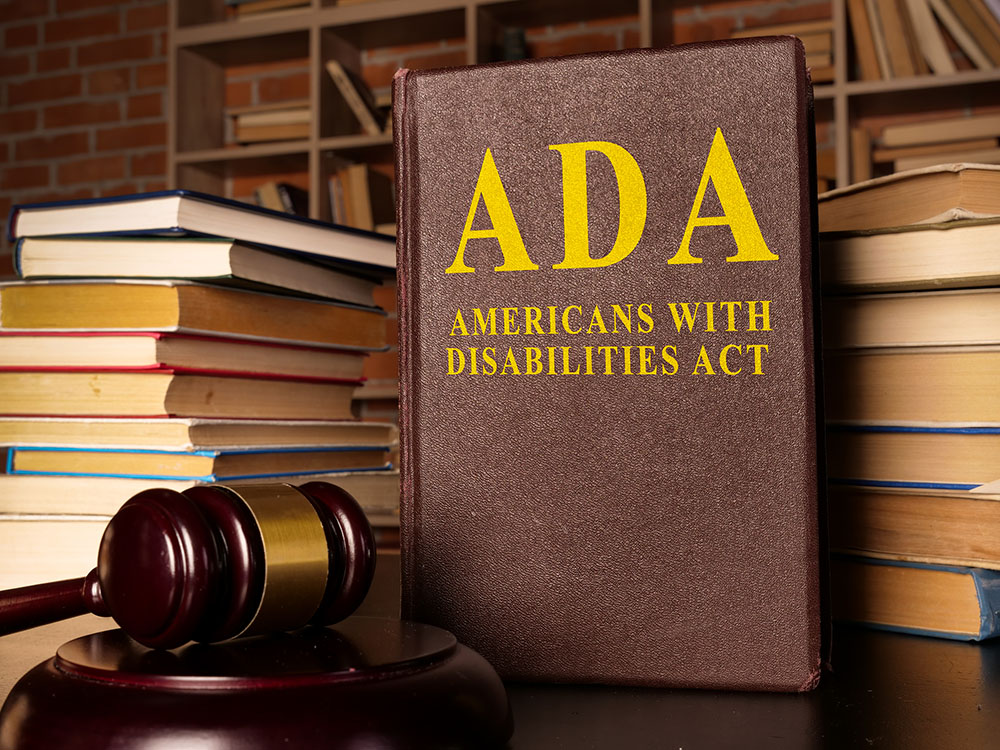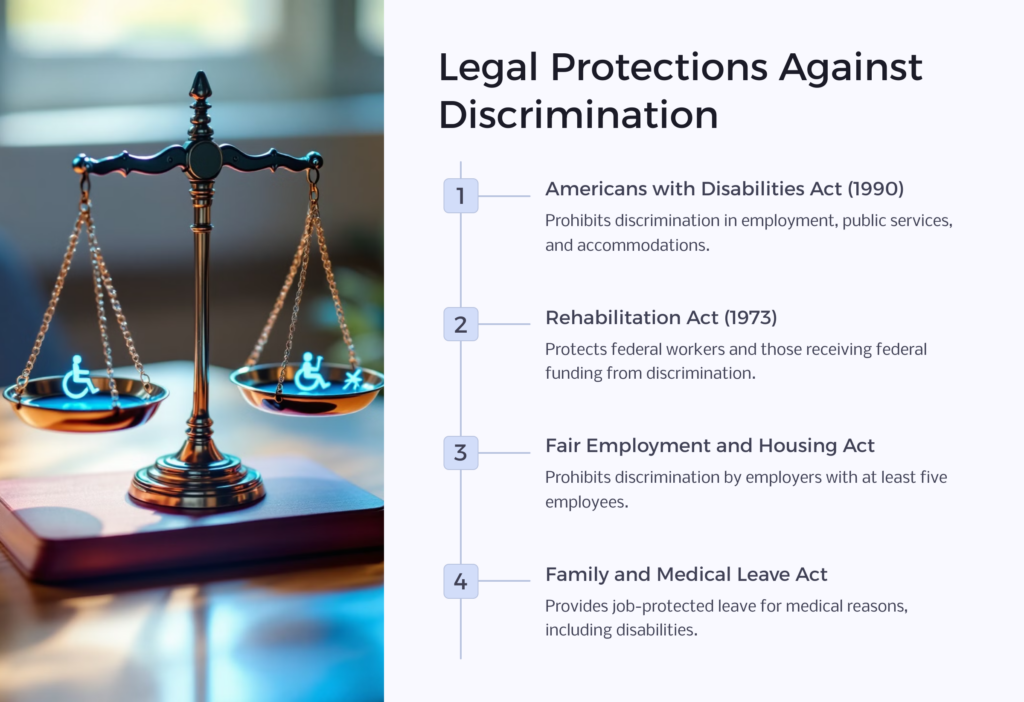One of the biggest barriers to success that workers living with disabilities are often faced with is disability discrimination in the workplace. Whether intentional or as a result of unconscious bias, disability discrimination can impede individual worker success and ultimately contribute to a hostile work environment and lack of productivity. Employers should familiarize themselves with disability discrimination in its various forms so they can guard against it in their workplace.

4 Types of Disability Discrimination in the Workplace
- Direct Discrimination
- Indirect Discrimination
- Harassment and Retaliation
- Failure to Accommodate Reasonable Requests
Legal protection exists at both the federal and state levels to protect disabled workers from discrimination in their workplaces. The goal is to help ensure that America’s workplaces are environments within which disabled workers can do their work without being treated inequitably.
To date, only 17.9% of disabled American adults are employed. Disabled workers have historically faced varying levels of disability discrimination in their places of work. As recently as 2019, the U.S. Equal Employment Opportunity Commission received and resolved 24,238 disability discrimination claims. And keep in mind that this does not include data from the states or local levels.
Disability discrimination can be hard to eradicate because of its tendency to shape-shift. It can manifest as several different conscious and unconscious behaviors. Disability discrimination is often the result of outdated organizational policies or a long history of homogenous hiring. It’s important for employers to be proactive, designing and implementing processes, policies, and procedures that accommodate employees’ physical or mental disabilities. Not only is it the right thing to do, but it’s also required by federal law.
What Is Disability Discrimination?
Under most laws, a person qualifies as disabled if the person has a mental or physical impairment that has a considerable, long-term detrimental effect on their ability to perform everyday tasks – or if the person has an impairment that automatically qualifies as a disability, such as cancer, multiple sclerosis, HIV, visual impairment, or severe disfigurement.
Disability discrimination is any type of inequitable treatment of an employee based on his or her disability status. Examples can include an employer terminating an employee because of disability-related absences, an employer blatantly refusing or failing to provide reasonable adjustments to help a disabled team member carry out work duties, an organization rescinding a job offer after learning of an individual’s disability, or an employee being bullied or harassed in the workplace because of their disability.
These are just a few of the ways disability discrimination can manifest. These behaviors are illegal and it is the employer’s responsibility to prevent them from occurring.
4 Types of Disability Discrimination in the Workplace
Workplace disability discrimination takes many forms – we’ve outlined some of the most common below.
Direct Discrimination
Direct discrimination represents a decision made against an employee based solely or primarily on that employee’s disability status. This could manifest as an employer deciding not to hire a potential employee, denying access to training, or providing less favorable working conditions for a disabled employee. It could even appear as an employer dismissing a team member because of their disability or even attempting to deny them unemployment insurance benefits.
In the case of standard direct discrimination, a disabled employee could be denied a promotion in favor of a non-disabled co-worker with less impressive credentials. In cases of direct discrimination by perception, an employee may be discriminated against based on a perceived disability the employer simply thinks they have. For example, an applicant may not be offered a position because the employer assumes the individual has a disability.
Direct discrimination by association occurs when an employee or potential employee suffers discrimination because of their association with another person with a disability. For example, an employee could be passed over for a promotion because the employee has a disabled child or parent who requires complex care arrangements.
In a disability discrimination case, a disabled team member who is fully qualified to do their job is claiming to have access to fewer choices and opportunities for their career development than a similar co-worker who is not disabled.
Indirect Discrimination
Indirect discrimination represents a case in which an employer has a particular policy, eligibility requirement, or general practice that applies to everyone but inappropriately places employees with a specific disability at a direct disadvantage.
An example of indirect discrimination would be when a team member with mobility issues is unable to take a scheduled break at their desk because their disability prevents them from walking to and from the breakroom during the allotted 15-minute break time. If company policy states that all team members must take a 15-minute break in the breakroom, then that policy may represent indirect discrimination.
In addition, creating or maintaining a physical work environment that includes physical barriers to the movement of anyone with a physical disability can be a form of indirect discrimination.
Harassment and Retaliation
Anytime an employee is subjected to unwelcome conduct regarding their disability, that behavior constitutes disability discrimination via harassment. Harassment can look like many different things – written, oral, or physical actions that are embarrassing, threatening, or hostile. Asking a job applicant invasive questions about their past or current medical conditions or requiring them to take a medical examination is a form of harassment.
In the worst cases, employees are taunted, called names, or openly insulted because they are working with a disability. Perhaps an employee is teased for parking in a handicapped space although they have an invisible disability that is not easily observed. It’s important to note that workplace harassment can come from many different levels within a work organization – supervisors, co-workers, and even clients all may be held accountable for harassing a team member with a disability.
Retaliation, a related offense, occurs when an employee suffers mental, emotional, or physical harm because they have filed a disability discrimination claim, supported the claim of another employee, or brought forward a specific report that relates to disability discrimination or workplace equity.
Failure to Accommodate Reasonable Requests

Failure to Accommodate makes up the bulk of disability discrimination cases in the workplace.
A “reasonable accommodation” is an adjustment or modification that allows a disabled team member to enjoy equal employment opportunities as individuals without disabilities.
Reasonable adjustments in the workplace that may help a disabled employee better perform a job’s essential functions may include anything from using an ergonomic keyboard or assistive computer software to sitting in a desk chair with additional back support. It may also encompass an employee with mobility issues needing a closer parking space or a work space on a ground floor if the building has no elevator. It could mean a modified work schedule, modified training materials, or the use of an interpreter in some cases.
If a disabled employee makes such a request, the employer is legally required to accommodate it whenever possible. Failure to do so may represent disability discrimination. It’s important also to note that the employer’s responsibility to accommodate an employee’s requested accommodations begins with the recruiting process, and accommodations are expected and required throughout the interview process.
Keep in mind that as the employee or prospective employee, you must make the request. An employer generally will not be held responsible for not making a reasonable accommodation if it isn’t specifically requested.
Whether a requested accommodation is “reasonable” will depend on several specific factors, including the associated costs, available resources, and how effective the accommodation is expected to be. It’s also important to note that if an employee claims that their employer failed to make reasonable accommodations, the employee must have a defined disability that is supported by medical documentation.
The law does not require that an employer make an accommodation if it causes the organization an undue hardship, typically defined as requiring significant difficulty or expense when considered in light of aspects like the employer’s size, financial resources, and the nature and structure of its operation. Whether an accommodation causes undue hardship must be decided on a case-by-case basis.
Laws Against Disability Discrimination

For employees with disabilities who are qualified to do their jobs, several federal laws are in place to protect them from disability discrimination, including harassment and retaliation. All workers, regardless of disability, also are protected from being a victim of workplace discrimination based on an association with a disabled person.

The Americans With Disabilities Act (1990)
The ADA covers all U.S. work organizations with at least 15 employees. The law makes it illegal for all private employers, state and local governments, employment agencies, and labor unions to discriminate against a qualified individual with a disability during the job application process, or in hiring, firing, advancement, compensation, job training, and other employment decisions.
Other sections of the ADA unrelated to employment deal with discrimination by governmental agencies and in public accommodations. Originally authored in 1990, Congress updated the ADA with the Americans with Disabilities Act Amendments Act of 2008. The changes are designed to make it easier for victims to get the help they need.
Under the ADA, the definition of a disabled person is someone who:
- Can show a documented physical or mental impairment that substantially limits one or more major life activities
- Has medical evidence to support this impairment
- May not be disabled (for example, eligible for SSDI benefits or workers’ compensation) but is regarded as having an impairment
The ADA also prohibits discrimination against anyone based on an association with a disabled person. Under the ADA, major life activities include things like breathing, seeing, hearing, walking, standing, lifting, bending, eating, sleeping, speaking, learning, reading, concentrating, thinking, communicating, and working, along with carrying out the daily activities associated with caring for oneself.
It’s important to note that the ADA not only protects those who have a documented disability, but also those who are treated as though they have a disability by their employer. Disability discrimination law is especially unforgiving of employers who act based on myths, fears, or stereotypes about a person’s medical condition. For example, an employer may not deny a job to a qualified candidate with a history of cancer because the employer fears that the condition will recur and cause the employee to miss a great deal of work.
The Rehabilitation Act (1973)
The Rehabilitation Act makes it illegal to discriminate against federal workers who are disabled. The law protects those who work directly for federal agencies as well as those receiving federal funding, such as federal contractors. The standards for determining disability discrimination under the Rehabilitation Act are the same as those used in the ADA.
The Fair Employment and Housing Act
The Fair Employment and Housing Act makes it illegal for any employer with at least five employees to discriminate against any job applicant or employee who is classified as part of a protected category, or to retaliate against them because they have asserted their rights under the law. Since disability is a protected class, this law is highly applicable in cases of alleged disability discrimination in the workplace.
The FEHA applies to both public and private employers, along with labor organizations and employment agencies.
The Family and Medical Leave Act
The Family and Medical Leave Act stipulates that eligible employees of covered employers may take unpaid, job-protected leave for specific family and medical reasons with continued group health insurance coverage under the same terms and conditions associated with their employment. Under the FMLA, employees are entitled to 12 work weeks per calendar year to deal with their own or a family member’s medical condition or disability.
Additional Protections
In addition to the major pieces of legislation governing treatment of disabled individuals in the workplace, several other protections exist for disabled people in other settings, such as travel, education, building design, and housing.
Many states also have laws in place to protect disabled employees from discrimination in the workplace. You can check your particular state’s Department of Labor website to find out more about any laws your state has in place.
Tips for Employers To Prevent Disability Discrimination in the Workplace

As an employer, one of your chief responsibilities is to create a workplace environment in which discriminatory behavior simply isn’t an option. We’ve outlined below some strategies to help you create that kind of healthy work environment.
1. Follow the Law
All employers should be familiar with both federal and state laws about disability discrimination so that they are fully aware of what disability discrimination law prohibits.
The most important thing you can do to prevent disability discrimination in the workplace is to follow the law’s requirements – at a minimum. This may require rewriting company policies, setting expectations with your team, providing reasonable accommodations, and putting measures in place to hold your team accountable for disability discrimination.
2. Create an Anti-Discrimination Policy
Your organization should also have a strong anti-discrimination policy in place, with clear and enforceable consequences. This policy should be discussed during the onboarding process for all employees. You may even consider having employees sign a statement that they have read and agree to abide by the anti-discrimination policy.
Make your anti-discrimination policy a permanent part of your employee handbook. You may want to consider having a qualified and knowledgeable attorney draft this policy for you to ensure that it’s in alignment with all federal and state laws regarding disability discrimination in the workplace.
3. Provide Training – Especially for Management
It’s important to invest in training for your entire company so that everyone is clear on company policy and what constitutes disability discrimination in your workplace. It is often most effective when training starts with senior leadership. Doing so sets a strong example and makes it clear where the company’s values lie. Your organization’s managers can serve as role models and be a positive influence on the wor
ers.
4. Make It Easy for Employees To Report Disability Discrimination
Provide appropriate and open channels for people to report disability discrimination. Make sure that there are clear processes for reporting disability discrimination, and actively encourage your employees to use them.
You may have to work diligently at first to create a culture in which people feel comfortable reporting discrimination without fear of retaliation. Encourage and reward such reporting.
Perhaps most importantly, be sure to take allegations of disability discrimination seriously and investigate them thoroughly. Only then will your processes and policies have true credibility with your team members.
5. Language Matters
In the interest of inclusivity, you can help your team members understand the importance of the language they use. Communicate that ableist language is not acceptable. This includes language that is inappropriate, offensive, or demeaning toward disabled people, including words or phrases some people may consider jokes or “just kidding around.”
You also should be sensitive to the terms you use to describe various disabilities. For example, steer clear of words or labels that are considered offensive or negative, like “retarded,” “crippled,” or “wheelchair-bound.” Other terms to avoid depend largely on people’s preferences and experiences, so it’s good to talk to disabled team members about what’s meaningful for them.
6. Create a Hiring Policy
Remember that an employee’s protection under the law extends into the recruitment and hiring process, so you should get familiar with what you can and cannot ask a candidate during an interview. Maintain clear recruitment and hiring practices that are designed with candidate equity in mind.

Disability Discrimination in the Workplace
Disability discrimination in the workplace is a historically pervasive and potentially damaging practice. Understanding where the law stands on disability discrimination – both at the federal and the state level – can go a long way toward building an inclusive environment for all workers.
With policies and practices put in place that encourage inclusion and deter discrimination, each employee can excel. While significant progress has been accomplished over recent decades, more efforts toward creating an inclusive workplace are still very much needed today.
Employers may want to consider adopting a hiring and retention strategy that focuses on attracting and retaining typically underrepresented populations, including workers who are disabled. This allows them to draw from the widest possible talent pool at all levels of hiring, to create a team that better reflects their customers and the wider community.
 Benefits.com Advisors
Benefits.com Advisors
With expertise spanning local, state, and federal benefit programs, our team is dedicated to guiding individuals towards the perfect program tailored to their unique circumstances.
Rise to the top with Peak Benefits!
Join our Peak Benefits Newsletter for the latest news, resources, and offers on all things government benefits.




















